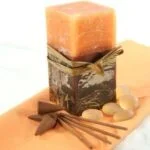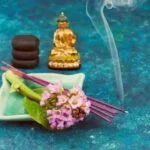Aromatherapy and essential oils are often used interchangeably, leading many people to assume they are one and the same. However, while there is a close relationship between the two, they are not identical. In this article, we will explore the distinction between aromatherapy and essential oils, delving into their definitions, histories, benefits, applications, and more.
To begin with, it is important to understand what each term means. Aromatherapy refers to the practice of using natural plant extracts, known as essential oils, to enhance physical and psychological well-being. These essential oils are highly concentrated liquids that capture the aromatic essences of plants through various extraction methods. They can be derived from flowers, leaves, stems, roots, or even fruits of different plants.
While aromatherapy focuses on utilizing these essential oils for therapeutic purposes, essential oils themselves have broader applications outside of aromatherapy. Essential oils can be used in skincare products, perfumes, cleaning agents, and more. They are versatile substances that contain unique chemical compounds responsible for their characteristic scents and potential health benefits.
In the following sections of this article, we will provide a comprehensive overview of both aromatherapy and essential oils individually before examining their relationship and discussing common misconceptions associated with them. By exploring their history, benefits, mechanisms of action, practical tips for implementation in daily life as well as safety guidelines for usage; we hope to clarify any confusion regarding these fascinating subjects. Let us embark on this enlightening journey to better understand aromatherapy and essential oils.
Understanding Aromatherapy
Aromatherapy has a long history that dates back thousands of years. This section will delve into the origins of aromatherapy and its purpose in promoting health and well-being.
The History of Aromatherapy
Aromatherapy can be traced back to ancient civilizations such as Egypt, China, India, and Greece. These cultures recognized the healing properties of plants and their aromatic essences. In ancient Egypt, essential oils were used for their medicinal and spiritual benefits. The Egyptians would extract oils from plants through a process called distillation and use them in various rituals and treatments.
In China, aromatherapy was incorporated into traditional medicine practices such as acupuncture and herbal remedies. Chinese medical texts dating back to 2697 BCE mention the use of aromatic substances for their therapeutic effects on the body and mind.
The practice of aromatherapy also has roots in Ayurveda, an ancient traditional medicine system from India. Ayurvedic practitioners used essential oils derived from herbs to balance the body’s doshas (energies) and promote overall wellness.
It wasn’t until the early 20th century that modern aromatherapy emerged as a distinct practice with the work of French chemist René-Maurice Gattefossé. Gattefossé’s interest was sparked when he accidentally discovered the healing powers of lavender oil after burning his hand in a laboratory accident. He coined the term “aromatherapie” to describe the medicinal uses of essential oils derived from plants.
The Purpose of Aromatherapy
The primary purpose of aromatherapy is to harness the therapeutic benefits of essential oils to enhance physical, emotional, and mental well-being. It is based on the principle that inhaling certain scents can stimulate specific areas in the brain that regulate emotions, memory, and hormonal responses.
Aromatherapy aims to holistically address imbalances in the body, promoting relaxation, stress relief, improved sleep quality, and overall vitality. It can be used as a complementary therapy to support various health conditions such as anxiety, depression, pain management, respiratory issues, and skin disorders.
Furthermore, aromatherapy is often used for its mood-enhancing effects. Different essential oils have unique properties that can uplift the spirit, promote mental clarity, boost confidence, or create a calming atmosphere.
By understanding the history and purpose of aromatherapy, individuals can appreciate its ancient roots and embrace it as a valuable practice in promoting well-being. The next section will explore essential oils in detail and how they contribute to the effectiveness of aromatherapy.
Essential Oils Explained
Essential oils have gained significant popularity in recent years, but what exactly are they? Essential oils are concentrated plant extracts that capture the characteristic aroma and beneficial properties of various plants. They are obtained through a process called steam distillation, which involves using steam to extract the aromatic compounds from different parts of the plant, such as the flowers, leaves, stems, or roots. The resulting oil contains the essence and unique fragrance of the plant it is derived from.
To understand how essential oils are made, it is important to grasp the concept of steam distillation. The process begins by placing the raw material, such as lavender flowers or peppermint leaves, into a still or distillation apparatus. Steam is then passed through the plant material, causing it to release its volatile compounds.
These volatile compounds evaporate along with the steam and pass through a condenser where they are cooled and transformed into liquid form again. The final product is a concentrated oil that contains all the natural components present in the plant.
Different plants yield different essential oils with varying scent profiles and therapeutic properties. For example, lavender essential oil is known for its calming and soothing effects on both the mind and body, making it popular in aromatherapy for relaxation purposes. On the other hand, tea tree oil has powerful antimicrobial properties and is commonly used for its ability to support skin health.
While most essential oils are derived through steam distillation, there are alternative methods for extraction depending on the plant involved. Some plants require a process called cold pressing or expression to obtain their essential oil. This method involves mechanically pressing citrus peels or certain plants’ seeds to extract their fragrant oils.
Delving into Aromatherapy
Aromatherapy, the practice of using essential oils for therapeutic purposes, offers a wide range of benefits and applications. The use of aromatherapy has been documented throughout history and is still widely practiced today.
One of the main benefits of aromatherapy is its ability to promote relaxation and reduce stress. Aromatherapy can help to calm the mind, reduce anxiety, and improve sleep quality. Certain essential oils, such as lavender and chamomile, have been shown to have sedative effects on the body, making them particularly effective for promoting relaxation.
In addition to promoting relaxation, aromatherapy can also support overall well-being. Essential oils have various properties that can benefit both physical and mental health. For example, eucalyptus oil has antimicrobial properties that can help fight off respiratory infections, while peppermint oil has been found to relieve headaches and improve focus.
Aromatherapy can be applied in various ways depending on the desired outcome. Popular methods include inhalation, where essential oils are added to a diffuser or inhaled directly from a bottle or tissue, and topical application through massage or adding a few drops to bath water. Some people also use essential oils in household cleaning products for their natural fragrance and antimicrobial properties.
Overall, aromatherapy offers a natural approach to enhancing well-being and improving mood. With its wide range of benefits and applications, it is no wonder that this ancient practice continues to be popular today.
| Aromatherapy Benefits | Aromatherapy Applications |
|---|---|
| Promotes relaxation | Inhalation (diffuser or direct inhalation) |
| Reduces stress | Topical application (massage) |
| Improves sleep quality | Topical application (bath) |
| Relieves headaches | Household cleaning products |
The Relationship Between Aromatherapy and Essential Oils
The relationship between aromatherapy and essential oils is often a subject of confusion and misconception. Many people wonder if they are simply two different terms for the same thing or if there is a deeper connection between the two. In order to understand this relationship, it is important to first define both aromatherapy and essential oils.
Aromatherapy, as the name suggests, refers to the use of aromatic plant extracts for therapeutic purposes. These plant extracts, also known as essential oils, are highly concentrated substances that possess the natural fragrances and beneficial properties of the plants from which they are derived. Essential oils can be extracted from various parts of plants such as flowers, leaves, stems, bark, and even roots.
Essential oils, on the other hand, are the pure essence derived from plants through processes such as distillation or cold pressing. They contain volatile compounds that give them their distinct aroma and therapeutic properties. These compounds have been used for centuries in traditional medicine practices for their physical and psychological benefits.
Clearing the Confusion
Dispelling the Myth of Aromatherapy as a New Age Trend
One common misconception surrounding aromatherapy is that it is merely a modern-day trend or fad. However, this belief overlooks the rich history and deep cultural roots of aromatherapy. In fact, the use of aromatic plants and essential oils for therapeutic purposes dates back thousands of years. Ancient civilizations such as the Egyptians, Greeks, and Chinese recognized and utilized the healing properties of aromatic substances.
Aromatherapy has been practiced in various forms throughout history and across different cultures. The Egyptians used essential oils for embalming rituals and medicinal purposes, while in ancient Greece, plants with aromatic qualities were used to promote well-being. Traditional Chinese medicine also incorporates aromatic substances in its practices. These historical references show that aromatherapy is not a passing trend but an age-old practice rooted in centuries of knowledge and experience.
Separating Fact from Fiction: Debunking Claims of “Cure-All” Solutions
Another myth surrounding aromatherapy and essential oils is the belief that they can cure all ailments or provide magical solutions to health issues. While aromatherapy can offer numerous benefits for physical and emotional well-being, it is important to approach it with realistic expectations.
Essential oils are powerful substances, but they should not replace medical treatment or be seen as a miracle cure. Aromatherapy works best when used as a complementary therapy in conjunction with conventional medicine. It can help support overall wellness, promote relaxation, relieve stress, alleviate pain, improve mood, enhance sleep quality, and boost immunity.
It is crucial to rely on evidence-based information regarding the uses and effects of essential oils. Consulting reputable sources such as scientific studies or qualified practitioners can help separate fact from fiction when it comes to aromatherapy claims.
The Importance of Quality: Addressing Concerns About Essential Oil Purity and Safety
One of the most prevalent concerns regarding essential oils is their purity and safety. Due to the growing popularity of aromatherapy, there has been an influx of essential oil suppliers, some of whom produce low-quality or adulterated products. It is essential for consumers to be cautious and ensure they are purchasing high-quality, pure essential oils.
Look for trusted brands that use third-party testing and adhere to strict quality standards. Pure essential oils should be sourced from plants without the use of synthetic additives or chemicals during the extraction process. Understanding the different methods of extraction, such as steam distillation or cold-pressing, can also help determine the quality of an essential oil.
Moreover, it is crucial to use essential oils safely and follow dilution guidelines provided by experts in aromatherapy. Undiluted essential oils can cause skin irritation or other adverse reactions if used improperly. Diluting them with carrier oils such as jojoba or almond oil helps reduce the risk of irritation while still allowing their therapeutic benefits to be experienced.
By addressing these concerns about purity and safety, individuals can confidently incorporate aromatherapy into their wellness routines and enjoy the potential benefits offered by high-quality essential oils.
The Science Behind Aromatherapy and Essential Oils
Aromatherapy and essential oils have gained popularity in recent years for their potential therapeutic benefits. But what exactly is the science behind these practices? This section delves into the scientific aspects of aromatherapy and essential oils, exploring their therapeutic properties and mechanisms of action.
Essential oils, which are the foundation of aromatherapy, are concentrated plant extracts derived through various methods such as steam distillation or cold pressing. These oils contain volatile compounds that give them their characteristic fragrance and potential therapeutic properties. The chemical composition of essential oils can vary depending on the plant species, growing conditions, and extraction method used.
The therapeutic effects of essential oils can be attributed to their complex chemical makeup. These oils contain a variety of bioactive molecules such as terpenes, phenols, aldehydes, and ketones that interact with the body in different ways. For example, some components may have anti-inflammatory properties, while others may have antimicrobial or analgesic effects. These bioactive molecules can interact with receptors in the body, such as olfactory receptors in the nose or neurotransmitter receptors in the brain, triggering physiological responses.
Research into aromatherapy and essential oils has shown promising results regarding their therapeutic potential. Studies suggest that certain essential oils may have antimicrobial properties against bacteria, fungi, and viruses. Others may possess antioxidant effects that can help protect against oxidative stress and inflammation. Some essential oils have even been investigated for their potential to improve mood and reduce anxiety or stress.
While scientific evidence supports some of the therapeutic claims associated with aromatherapy and essential oils, it is important to note that further research is still needed to fully understand their mechanisms of action and effectiveness. Additionally, it is crucial to use essential oils safely and properly, as they are highly concentrated substances that can cause skin irritation or adverse reactions if not used correctly.
Understanding the science behind aroma therapy helps us appreciate its potential benefits better while using this practice cautiously. Continued research in this field will help expand our knowledge and uncover new therapeutic applications for essential oils.
Practical Tips for Incorporating Aromatherapy and Essential Oils into Your Daily Life
Aromatherapy and essential oils offer a wide range of benefits and can be easily incorporated into your daily life. Here are some practical tips for making the most out of aromatherapy and essential oils:
- Choosing the Right Essential Oils: Start by selecting essential oils that align with your specific needs and preferences. Consider the scents that you find most appealing, as well as the therapeutic properties associated with different oils. For example, lavender oil is known for its calming effects, while peppermint oil can help increase focus and energy.
- Diffusing Essential Oils: One popular way to use essential oils is through diffusers, which disperse the scent into the air. Add a few drops of your chosen oil to water in a diffuser, and enjoy the aroma as it fills your space. This method is great for creating a relaxing ambiance in your home or office.
- Creating Personalized Blends: Another fun way to incorporate aromatherapy into your life is by creating personalized blends of essential oils. Experiment with various combinations to find scents that you like and that serve a specific purpose. For example, mixing bergamot and ylang-ylang oils can create a blend that promotes relaxation and reduces stress.
- Topical Application: Many essential oils can be applied topically to provide various health benefits. However, it’s important to dilute them properly before using them on your skin, as they can be very potent in their pure form.
- Incorporating Aromatherapy into Daily Routines: Look for opportunities throughout the day to integrate aromatherapy into your routine. For example, adding a few drops of an invigorating essential oil like citrus or eucalyptus to your morning shower can help wake you up and boost your mood.
Incorporating aromatherapy and essential oils into your daily life doesn’t have to be complicated or time-consuming. By following these practical tips, you can experience the many benefits that these natural remedies have to offer.
| Tips for Incorporating Aromatherapy and Essential Oils into Your Daily Life |
|---|
| 1. Choose the right essential oils based on your needs and preferences |
| 2. Use diffusers to disperse the scent of essential oils in your space |
| 3. Create personalized blends of essential oils for specific purposes |
| 4. Dilute essential oils properly before applying topically to the skin |
| 5. Find opportunities throughout the day to incorporate aromatherapy into your routine |
Considering Safety and Caution
Proper usage and dilution guidelines are crucial when it comes to practicing aromatherapy and using essential oils. Although these natural products offer numerous benefits, it is important to understand that they are highly concentrated substances that can be harmful if used improperly or in excessive amounts. Therefore, it is essential to follow safety precautions and guidelines to ensure the effective and safe use of aromatherapy and essential oils.
Firstly, it is crucial to remember that essential oils should not be ingested unless under the guidance of a qualified aromatherapist or healthcare professional. Ingesting essential oils without proper knowledge and guidance can lead to serious health risks. Essential oils are meant for external use only, such as through inhalation or topical application.
When using essential oils topically, they must always be diluted with a carrier oil before applying them to the skin. Undiluted essential oils can irritate and sensitise the skin, leading to allergic reactions or other adverse effects.
The recommended dilution ratio is typically 2-3 drops of essential oil per 10 mL (or 1 tablespoon) of carrier oil. Carrier oils such as coconut oil, almond oil, or jojoba oil help to dilute the potency of the essential oil while providing moisturization and nourishment to the skin.
Moreover, different essential oils have different safe usage levels due to their varying chemical compositions. Some essential oils may be safe for daily use in low concentrations, while others may require more caution due to their potential for toxicity or sensitivity reactions. It is important to research each individual essential oil before use and consult reputable sources or professionals who can provide specific dosage recommendations.
Conclusion
In conclusion, it is clear that while aromatherapy and essential oils are closely related, they are not the same thing. Aromatherapy is a holistic healing practice that utilizes essential oils as one of its tools. Essential oils, on the other hand, are concentrated plant extracts that can be used in various ways beyond just aromatherapy.
Throughout this article, we have explored the history and purpose of aromatherapy, as well as delved into the process of making essential oils. We have discussed the benefits and applications of aromatherapy, debunked misconceptions and myths surrounding both aromatherapy and essential oils, and explored the science behind their therapeutic properties.
It is important to note that when incorporating aromatherapy and essential oils into our daily lives, safety and caution must be prioritized. Dilution guidelines should be followed to ensure proper usage, and if any adverse reactions occur, immediate medical attention should be sought.
Ultimately, it is up to individuals to decide whether they prefer the holistic approach of aromatherapy or simply utilizing essential oils in other ways. Both have their merits and can provide support for overall well-being. The key takeaway from this debate is understanding that while they may overlap in some areas, aromatherapy and essential oils each have their own unique purpose in wellness practices.
Frequently Asked Questions
What is the difference between essential oils and aromatherapy?
The difference between essential oils and aromatherapy lies in their purpose and application. Essential oils are concentrated extracts derived from plants, typically through methods like steam distillation or cold pressing. These oils capture the natural scents and chemical compounds of the plants they are obtained from.
On the other hand, aromatherapy is a holistic healing practice that utilizes essential oils to promote physical, emotional, and mental well-being. While essential oils are the primary tools used in aromatherapy, the practice also involves other elements such as massage, inhalation, or diffusion techniques to provide therapeutic benefits.
Can I use aromatherapy oils on my skin?
Aromatherapy oils can generally be used on the skin, but it is important to exercise caution and dilute them appropriately before application. The pure undiluted form of most essential oils can cause skin irritation or sensitization when directly applied without dilution. To ensure safety, it is recommended to blend essential oils with carrier oils such as coconut oil or jojoba oil before using them topically on your skin.
This helps to minimize any potential adverse reactions while still allowing you to benefit from the therapeutic properties of the essential oil. Additionally, it’s advisable to perform a patch test on a small area of your skin before using any new essential oil topically.
What are the 7 essential oils?
There are numerous essential oils available with a wide range of benefits; however, it can be challenging to narrow down seven specific ones considered “essential.” That being said, some commonly recognized essential oils are lavender, lemon, peppermint, tea tree, eucalyptus, chamomile, and rosemary.
Each of these oils has unique properties and potential health benefits associated with them when used correctly in aromatherapy practices.

Are you looking for a natural way to improve your health and wellbeing?
If so, aromatherapy may be the answer for you.





